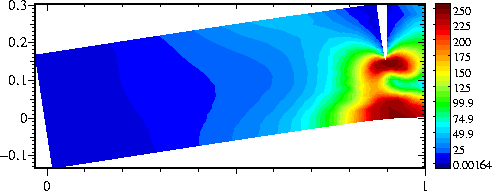MEK-INF 4210/3210
Modeling of fluid flow, heat transfer and solid deformation
Where and when: Tuesdays 9:15-12:00 and Wednesdays 9:15-10:00
in room V414, 3rd floor in the Physics building.
Starting August 24, 2004.
More information about the teaching (slides,
exercises, plan, etc.)
All teaching on Wednesdays 9-12 (no teaching on Tuesdays).
What kind of course is this?
This course gives an overview of continuum models,
formulated as systems of partial differential equations,
for fluid flow, heat transfer, and elastic-plastic deformation.
Such models are widely used throughout science and engineering.
With modern computers and software it has become
possible to apply the models far beyond the classical applications
found in mechanics and physics books.
The goal of the course is to present continuum mechanics from
a modern point of view, i.e., the mathematical formulation and
problem solving techniques are adapted to the computer age and
not to the restrictions of what you can do with pencil and paper.
This modern use of continuum mechanics is, unfortunately, not well
documented in texbooks. That is why we think a structured course
will be a help for students and scientists who get in contact with
continuum mechanical models, either from a physical,
engineering, or mathematical perspective.
If you plan to follow the course, please drop an email to
Hans Petter Langtangen (hpl@simula.no).

What kind of background do I need?
You need to be familiar with calculus and some linear algebra.
Familiarity with scalar and vector fields are particularly important.
It is an advantage to have some experience with the
stress concept (and the stress tensor).
How is the teaching organized?
The course consists of two parts, taught in parallel:
-
Part 1: Simplification and adaption of general models for fluid flow,
heat transfer, and elastic deformation to specific industrial or
scientific applications.
In examples and exercises we start with the general governing
equations for the phenomenon of interest and introduce
simplifications like dimension reduction, use of symmetries,
removal of negligible physical effects, etc.
Sometimes the resulting equations are sufficiently simple to allow
straight integration by hand, but normally numerical solution methods
are demanded. In both cases we put strong emphasis on formulating
the mathematical problem in
a complete way, i.e., as a system of partial differential equations with
the correct number of initial and boundary conditions.
We do not discuss numerical solution methods in this course
(but this the a topic of a companion course in the spring term).
-
Part 2: A general framework for building mathematical models for
fluid flow, heat transfer, and elasto-plastic deformation.
In this part, the close relation between a variety of fluid flow
models, heat transfer models, and deformation models is shown.
All of the models are derived from a simple framework based on
mass conservation, Newton's 2nd law of motion, and the first law
of thermodynamics. In addition, we need a series of
(uncertain) constitutive laws. The focus is on overview and how to
formulate the models.
Teachers
- Hans Petter Langtangen.
He is professor of mathematical modeling
at the Department of Informatics (UiO). He has previously been
a professor of mechanics at the Department of Mathematics (UiO).
The present course is a further development of a course in continuum mechanics
(ME211) that he has taught in the math department since 1994.
- Joakim Sundnes. He has a master's degree in mechanics and a
PhD in numerical simulation. He is an adjunct assistant professor
at the Department of Informatics.
Langtangen og Sundnes are currently employed at
Simula Research Laboratory,
Department of Scientific Computing.
Langtangen is also associated with
Physics
of Geological Processes (PGP), a center of excellence at the University
of Oslo. The lectures in the present course are given in
this center's seminar room.

